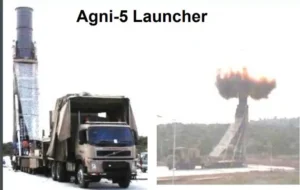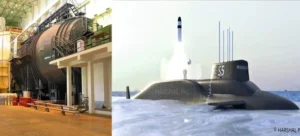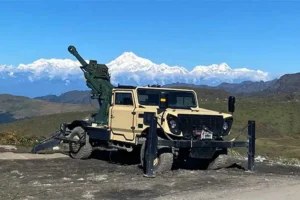 |
| B-21 Raider 6th Generation Stealth Bomber unveiled by US Air Force and American compnay Northrop Grumman |
The B-21 ‘Raider’ demonstrates that the US stealth technology has genuinely taken a massive leap forward. Unveiled at Palmdale in California in the early morning on December 3, the B-21 Raider, with its 9,600 km range and roughly 10-ton payload, is the only hope of being able to fight China and stay out of its missiles’ ranges.
The indication of the unparalleled American lead in stealth aviation is the frontal view of the plane – albeit it was the only angle revealed.
The thin air intakes are the single biggest indicator of the engine and materials technology employed in the plane. Having large intakes increases the chances of radar bouncing off the aircraft as it has more surface to reflect from.
The B-21 Raider has been known to be developed as a subsonic aircraft and not meant for the tight maneuvers of a fighter. Its unveiling and eventual deployment would be the first credible tool with the US against its massive range of logistical, technological, and doctrinal weaknesses before China in the Western Pacific.
The color scheme was white and did not have the peculiar stealth pattern of sharp edges and serrations seen on the B-2. Whether this was not the final paint scheme is not known.
But it can be safely assumed that Northrop has worked on moving from the expensive radar coating paint and materials whose wearing off often keeps a lot of B-2s in the hangar.
Why the US Needs the B-21 Against China
China’s thousands of DF-16, DF-17, DF-21, DF-21D, and DF-26 missiles have every major US base in range and will be the first ones to be taken out in case of a full-scale war. With Kadena in Japan and Guam’ bombed out’, the US can only watch helplessly as China surrounds and seizes Taiwan.
If the US intervenes, the Chinese can comfortably keep fighting from the home turf and keep shooting down any American naval and air assets while taking some acceptable and anticipated level of material and personnel losses.
If the People’s Liberation Army Rocket Force (PLARF) missiles fail, the People’s Liberation Army Navy (PLAN) and the People’s Liberation Army Air Force (PLAAF) have the numbers and technology to prevent US intervention, while the rest of its military seizes Taiwan.
This, therefore, makes the B-21 strategic stealth bomber, including the B-52s, the B-1 Lancer, and the B-2 Spirit, its leading edge in the war in the western Pacific.
There have been calls to make around 150-200 planes, and that stage is still a long way. Northrop Grumman CEO Kathy Warden laid out the standard “robust ground testing and first flight” stages.
Possibly taking at least two years, it will see massive tweaking and modifications to finalize the series production model.
But Northrop claims that, too, has been taken care of with the “digital twin” approach, where an exact digital replica has been created to envision and study the impact of various technical tweaks. Combined with its “open architecture” design, the upgrade process has been claimed to be faster and as effective.
The plane would cost $203 billion to develop, operate and purchase 100 aircraft over 30 years, according to estimates provided to Bloomberg by the US Air Force (USAF). The estimated per unit cost, meanwhile, remains under the $550 million target. To make a difference, it all depends upon how fast Northrop churns out the series production and with what changes.
What Do We Know So Far?
Two days before Northrop Grumman unveiled the B-21 ‘Raider’, it revealed it to be a deep penetration, intelligence-surveillance-reconnaissance (ISR)-centric bombing and electronic attack platform.
Describing it as a sixth-generation aircraft, the company has abandoned the ‘block’ approach for future upgrades. The “digital twin” and “digital engineering” industrial manufacturing processes bring their own cost-saving benefits.
The plane has been expected to break through and evade Chinese radars, air defense systems and release its payload of missiles and bombs on sensitive ground targets before flying back.
Judged to be more advanced than China’s and Russia’s under-development H-20 and PAK-DA stealth bombers, there is considerable consternation in Beijing and Russia over the Raider’s capabilities.
Generation 6 – An Undefined Concept?
In a statement reported by Air and Space Forces Magazine, the company said that the Raider “has been designed as the lead component of a larger family of systems that will deliver intelligence, surveillance and reconnaissance, electronic attack and multi-domain networking capabilities.”
This means getting battlefield information and sending them to friendly forces is a primary role, along with bombing and missiles, with both possibly being performed simultaneously.
Therefore, ISR and electronic warfare (EW) is a new role for a dedicated strategic stealth bomber, possibly setting the stage for the definition and configuration of Generation 6 aircraft, which has yet to be articulated.
Military aviation experts have long been divided over what Gen. 6 technologies and capabilities in combat aircraft might entail. Some leading analysts like Alexander Yermakov of the Russian International Affairs Council (RIAC) dismissed the category as an “artificial” concept created by aviation historians and “marketing executives.”
More autonomy with a higher proportion of artificial intelligence (AI); engines that are an evolution of jet propulsion; sleeker bodies, possibly without vertical stabilizers (tails) for greater stealth; even more powerful radars and; the ability to fire directed energy weapons (DEW). These are some of the features experts have reached a broad consensus on.
Given the evolution of US military aviation technology and the troubled state of its Gen. 5 fighters like the F-22 and F-35, it is unlikely the Raider will be a radical departure from Gen. 5 to Gen. 6. It may help coherently direct the development of Gen. 6 technologies, possibly serving as an unintended technology demonstrator.
During its subsequent decades in service, as it sees upgrades and possibly sees military operations against peer adversaries Russia and China, aviation technologists, air power theorists, pilots, and military planners will have a clearer idea of the next evolutionary stage.
It is pertinent to remember that the United States developed Gen. 5 stealth fighters in the 30-year unipolar era, where it had no economic, technological or military rivals.
The contribution of Russia and China – nearly caught up and capable of dealing a severe blow to the US military – to the debate on the future of combat aviation would be significant and cannot be ignored.
Northrop Grumman Reveals
Northrop says the B-21 will rely on “external support platforms or systems.” Whether these are escort aircraft, bomber-launched vehicles, satellites, or other technology is unclear.
Air Force Secretary Frank Kendall recently announced shelving the plan to develop dedicated autonomous, long-range, collaborative combat aircraft (CCA or ‘wingmen’) for the B-21.
These were meant to escort the B-21 deep into enemy territory. But the bomber would still launch decoys, jamming vehicles, or ISR drones.
The plane has been designed in a modular, open architecture framework for “rapid upgradeability,” dumping the “block upgrades” approach. “The B-21 uses agile software development, advanced manufacturing techniques, and digital engineering tools to help mitigate production risk.” Whether this means 3D printing processes is unclear but cannot be ruled out.
The Raider “will provide the Air Force with long range, high survivability, and mission payload flexibility. The B-21 will penetrate the toughest defenses for precision strikes worldwide.”
Calling the B-21 the “backbone of the future for US airpower,” Northrop Grumman said the B-21 has “advanced integration of data, sensors, and weapons,” capable of delivering both conventional and nuclear payloads and “a broad mix of stand-off and direct attack munitions.”







